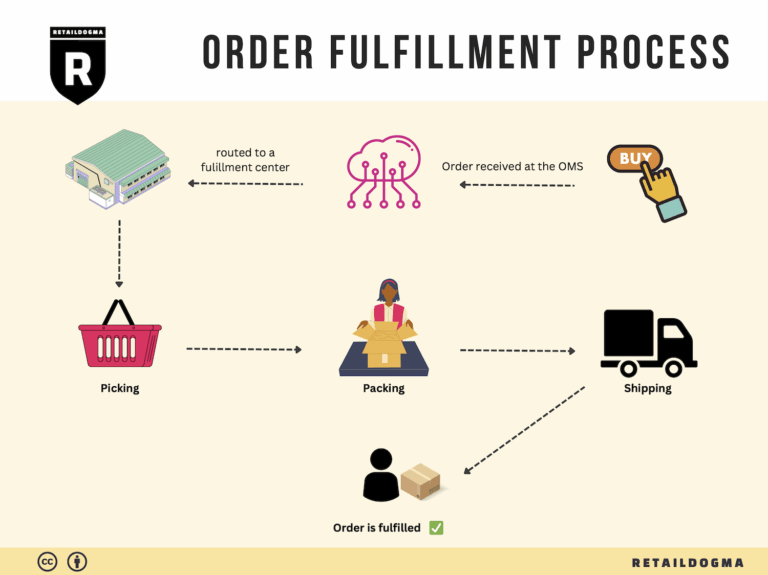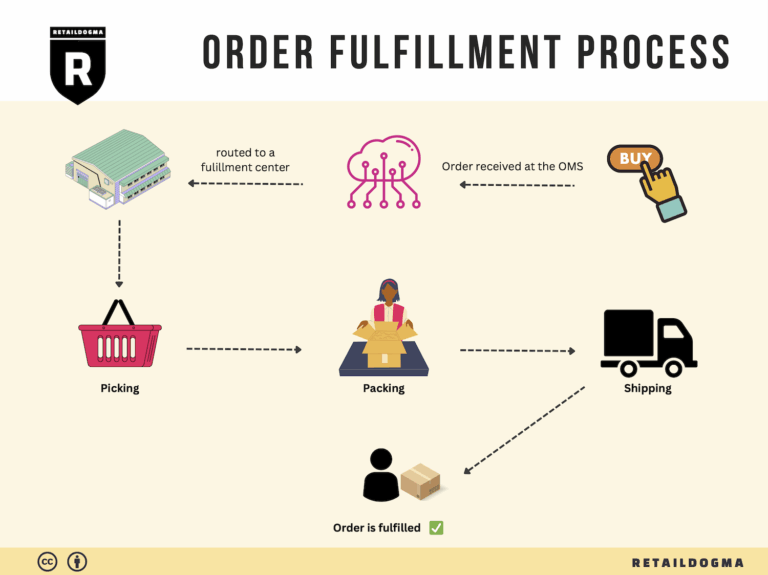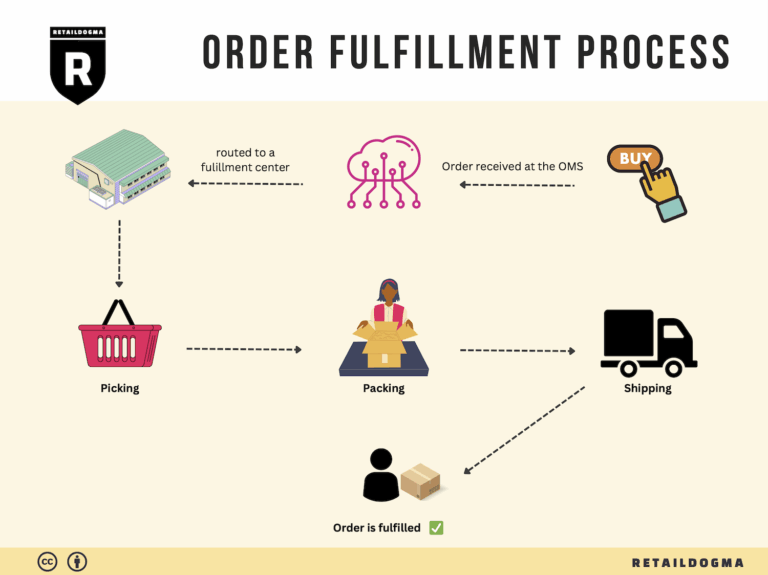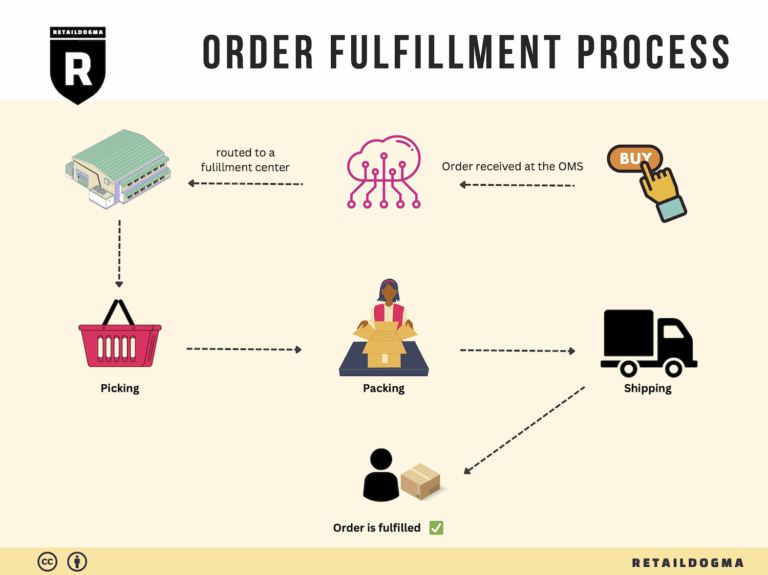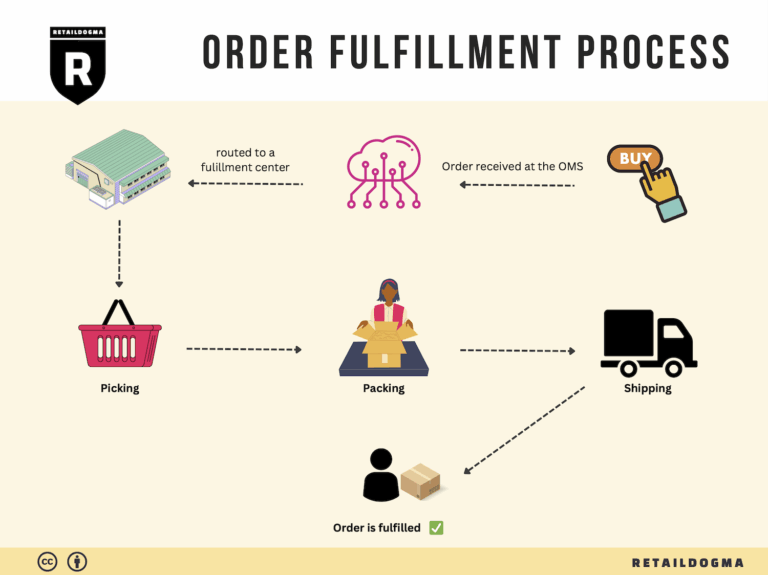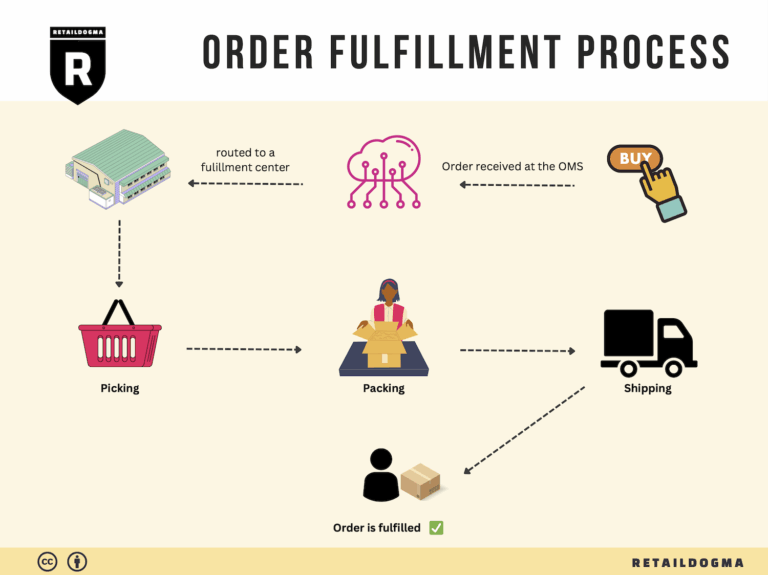What Is A Fulfillment Center? A Complete Guide (2025)
What is E-commerce Fulfillment? An Introduction for Growing Businesses
Understanding E-commerce Fulfillment: A Key to Scaling Your Business
As your online business grows, the excitement of increased sales can quickly turn into stress when it comes to managing the logistics of packing and shipping orders. Many entrepreneurs find themselves overwhelmed by the sheer volume of orders, leading to potential delays and dissatisfied customers. This is where e-commerce fulfillment comes into play, serving as a vital link between you and your customers.
E-commerce fulfillment is the comprehensive process of getting a product from your inventory into the hands of your customer. It involves several steps, including receiving orders, picking items from storage, packing them securely, and arranging for shipping. While this may sound straightforward, the intricacies involved can become daunting as your business scales. Without the right fulfillment strategy, you risk losing precious time and resources, which could otherwise be invested in growing your brand.
In this guide, we will delve into various fulfillment models that can support your business as it expands. You’ll learn about Third-Party Logistics (3PL) providers, Fulfillment by Amazon (FBA), and other options that can streamline your operations. We will explore the core services associated with fulfillment, such as inventory management, pick and pack services, return processing, and shipping options.
Choosing the right fulfillment partner is crucial for your success. We will provide insights into what to look for in a logistics partner, including factors like reliability, technology integration, and customer service. Additionally, we’ll break down pricing structures, helping you understand the costs associated with different fulfillment services so that you can make informed financial decisions.
Ultimately, this guide aims to empower you, the business owner or operations manager, with the knowledge and tools needed to make smart logistical choices. By understanding e-commerce fulfillment and its impact on your operations, you can enhance customer satisfaction, reduce operational headaches, and focus on what truly matters: growing your business. Prepare to transform your fulfillment process from a burden into a competitive advantage.
What You’ll Learn In This Guide
- What is E-commerce Fulfillment? An Introduction for Growing Businesses
- The Order Fulfillment Process: From ‘Buy’ Button to Customer’s Door
- Comparing Fulfillment Models: In-House vs. 3PL vs. Dropshipping
- A Deep Dive into Amazon FBA: Pros, Cons, and Who It’s For
- Core Services Offered by Fulfillment Centers
- How to Choose a Fulfillment Partner: A 6-Point Checklist
- Understanding Fulfillment Pricing: A Breakdown of Common Fees
- Frequently Asked Questions (FAQs) about Fulfillment
- Conclusion: Is Outsourcing Fulfillment the Right Move for Your Business?
- Important Disclaimer
The Order Fulfillment Process: From ‘Buy’ Button to Customer’s Door
1. Receiving Inventory
The order fulfillment process begins with receiving inventory, which is a critical step that sets the foundation for smooth operations. During this stage, products are delivered from suppliers to your warehouse or fulfillment center. Upon arrival, the items are checked against the purchase order to ensure accuracy in quantity and specifications.
Key Term: SKU (Stock Keeping Unit)
Each product is assigned a unique SKU, which helps in tracking inventory efficiently. This identification system allows businesses to manage stock levels and facilitate easy retrieval of items.
This step is crucial as it ensures that your inventory levels are accurate from the outset. Discrepancies can lead to stockouts or overstock situations, both of which can negatively impact customer satisfaction and cash flow. Effective receiving processes also set the stage for accurate inventory management, minimizing errors in subsequent steps.
2. Warehouse Storage
Once inventory is received, the next phase involves storing these items in a designated area within the warehouse. Efficient warehouse storage strategies are vital for optimizing space and ensuring that products are easily accessible when orders come in.
Key Term: FIFO (First In, First Out)
This inventory management method ensures that older stock is sold before newer stock, reducing the risk of obsolescence and spoilage, especially for perishable goods.
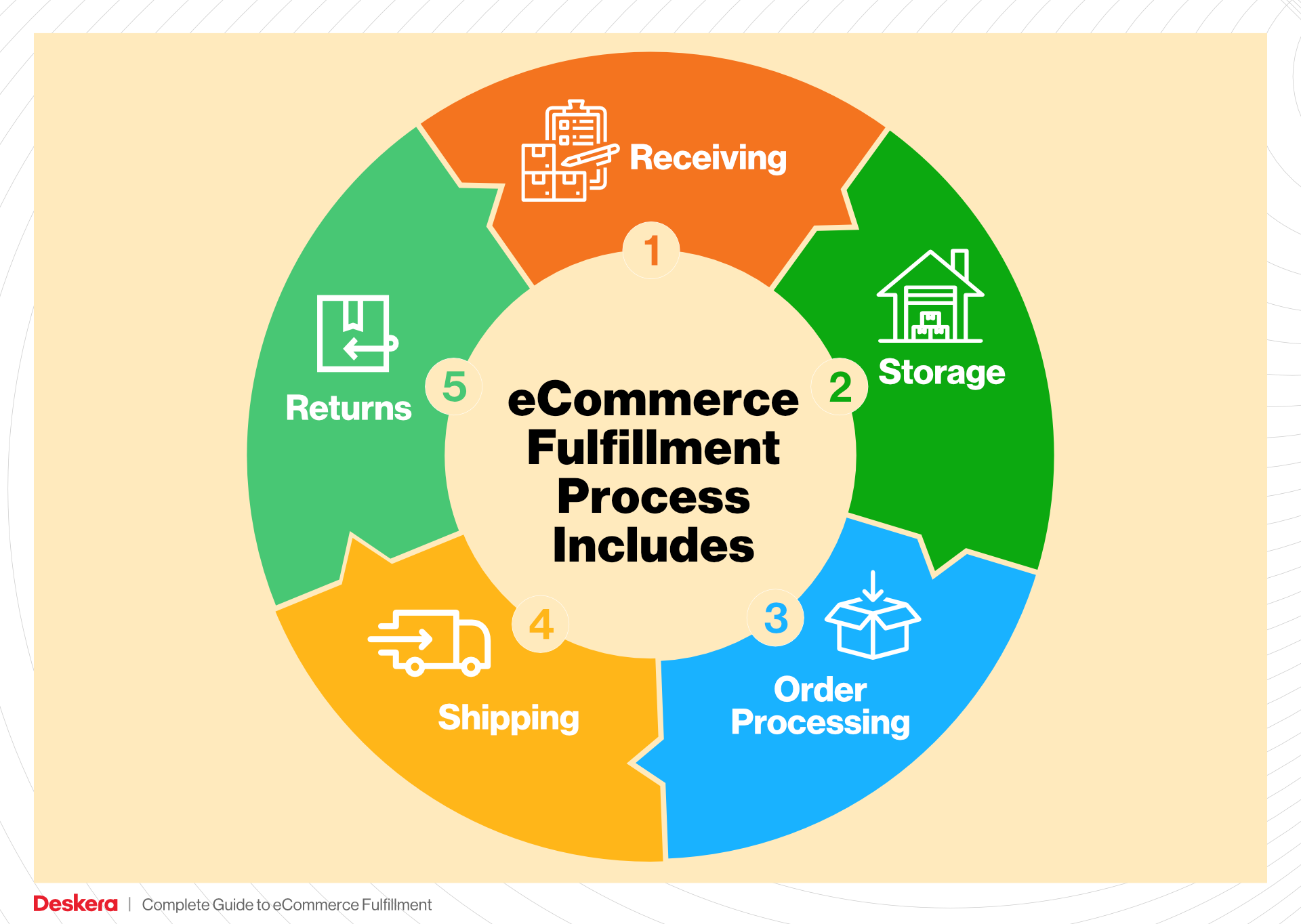
Proper warehouse organization can significantly enhance picking efficiency. Implementing a well-structured storage system—such as zoning by product type or popularity—enables quicker retrieval and minimizes delays in fulfilling customer orders. This step not only affects operational efficiency but also has a direct impact on order fulfillment speed and accuracy.
3. Order Picking
When a customer places an order, the next step is order picking, which involves selecting the correct items from the warehouse for shipment. This process can be executed through various methods, including single order picking (one order at a time) or batch picking (multiple orders at once), depending on the volume of orders and warehouse layout.
Key Term: Pick Lists
A pick list is generated for each order, detailing the items and their locations within the warehouse. This document is essential for guiding warehouse staff to efficiently gather the required products.
Order picking is pivotal for maintaining order accuracy and minimizing fulfillment time. An efficient picking process ensures that the right products are selected, reducing the likelihood of returns due to incorrect items being shipped. The faster and more accurately orders are picked, the better the overall customer experience.
4. Order Packing
After items have been picked, they move to the packing stage. This step involves carefully packing the items into boxes or containers, ensuring they are secure for transit. It’s also an opportunity to enhance the customer experience through branding and presentation.
Key Term: Packing Slip
A packing slip is included with the shipment, detailing the contents of the package. This document not only serves as a receipt but also reassures the customer that they received the correct items.
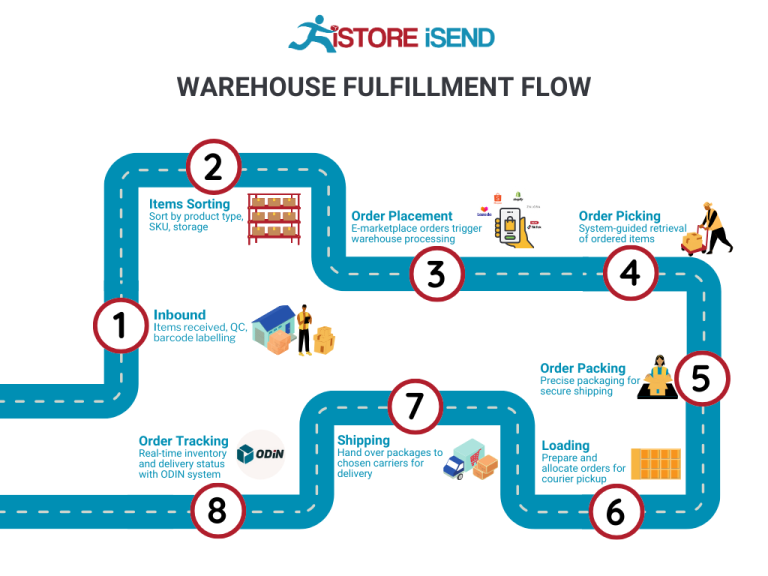
Effective packing is essential for preventing damage during shipping, which can lead to costly returns and diminished customer satisfaction. Additionally, thoughtful packaging can create memorable unboxing experiences, encouraging repeat business and fostering brand loyalty.
5. Shipping & Delivery
The final step in the order fulfillment process is shipping and delivery. Once packages are packed, they are handed over to a shipping carrier for transportation to the customer’s address. This stage includes selecting the appropriate shipping method based on factors such as cost, speed, and destination.
Key Term: Tracking Number
A tracking number is assigned to each shipment, allowing customers to monitor their order’s journey from the warehouse to their doorstep.
This step is crucial as it directly impacts customer satisfaction. Timely and accurate delivery builds trust and encourages future purchases. Moreover, efficient shipping processes can reduce costs and improve profitability by leveraging partnerships with reliable carriers. A well-executed shipping strategy ensures that customers receive their orders in a timely manner, enhancing their overall experience and increasing the likelihood of repeat business.
In conclusion, understanding and optimizing each step of the order fulfillment process—from receiving inventory to shipping and delivery—allows e-commerce businesses to scale effectively, improve customer satisfaction, and maintain a competitive edge in the market.
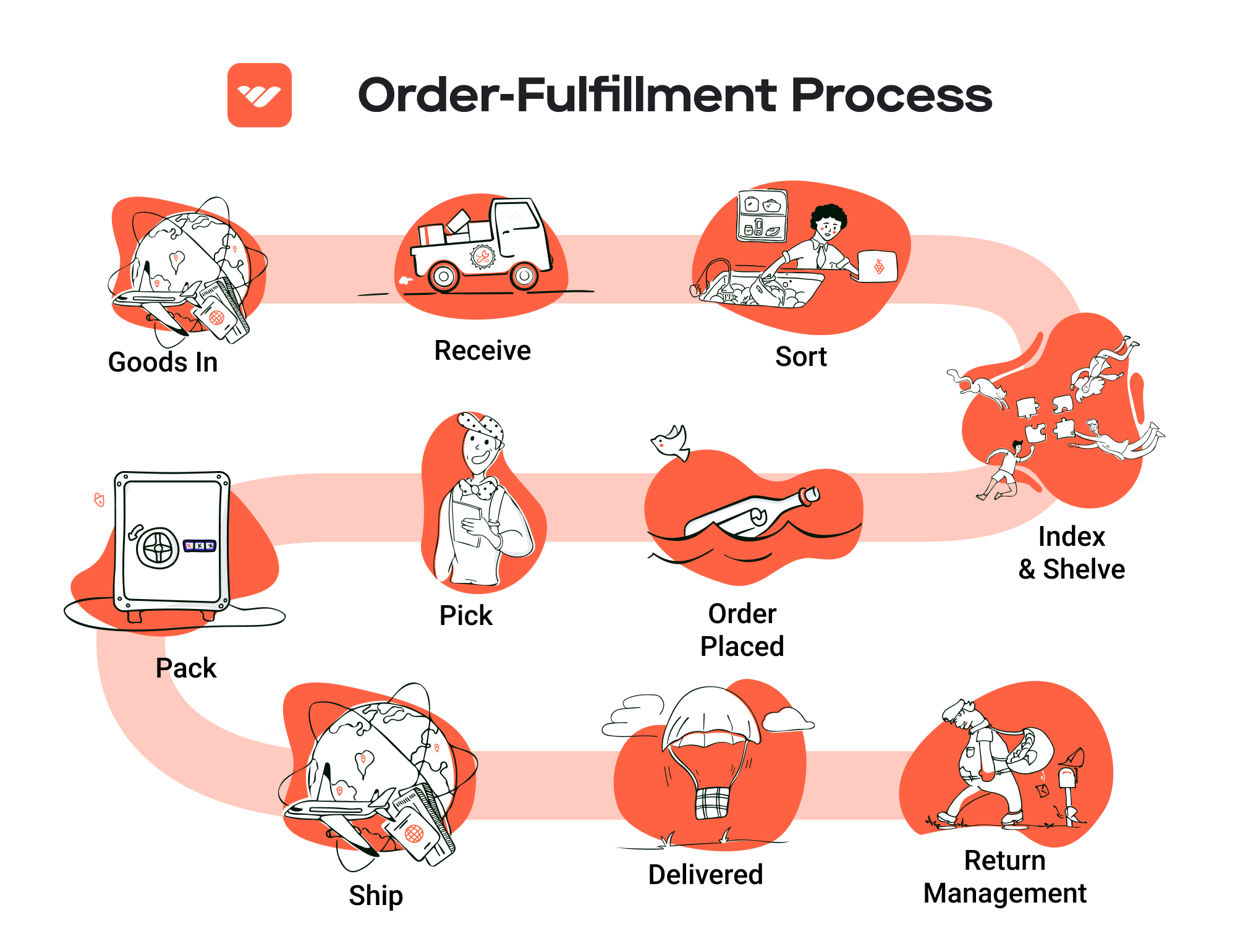
Comparing Fulfillment Models: In-House vs. 3PL vs. Dropshipping
Fulfillment Model Comparison
| Model | Who Handles Inventory | Best For (Business Stage) | Key Advantage | Key Disadvantage |
|---|---|---|---|---|
| In-House Fulfillment | The business itself | Start-ups to Established | Full control over inventory and processes | High overhead costs and resource demand |
| Third-Party Logistics (3PL) | Third-party provider | Growing to Established | Scalability and reduced operational burden | Less control over fulfillment processes |
| Dropshipping | Supplier | Start-ups and Small Brands | Low initial investment and risk | Lower profit margins and potential delays |
In-House Fulfillment
In-house fulfillment refers to the process where an e-commerce business manages its own inventory and shipping operations directly. This model is most suitable for businesses that are in the start-up phase or have established operations and want to maintain complete control over their logistics. One of the primary advantages of in-house fulfillment is that businesses can oversee every aspect of the fulfillment process, from inventory management to packaging and shipping, ensuring brand consistency and quality control. However, this model comes with significant drawbacks, including high overhead costs associated with warehousing, staffing, and technology investments. As the business grows, the demands on resources can increase exponentially, making it challenging to scale efficiently. Businesses must also stay vigilant about managing their logistics operations, which can divert focus from core competencies like product development and marketing.
Third-Party Logistics (3PL)
Third-party logistics (3PL) providers specialize in managing logistics and fulfillment services for e-commerce businesses. This model is ideal for growing businesses that need to scale their operations without the burden of managing warehousing and shipping themselves. By outsourcing fulfillment to a 3PL, companies can benefit from the provider’s expertise, technology, and established shipping networks. The key advantage of this model is the scalability it offers; businesses can adjust their fulfillment strategies based on demand without incurring the fixed costs of maintaining their own logistics infrastructure. Additionally, 3PLs often have optimized processes that can lead to lower shipping costs and faster delivery times. However, a significant downside is the reduced control over the fulfillment process. Businesses may face challenges in aligning their brand’s identity with the 3PL’s operations, which can impact customer satisfaction if not managed properly.
Dropshipping
Dropshipping is a fulfillment model where the retailer does not keep products in stock. Instead, when a product is sold, the retailer purchases the item from a third-party supplier, who then ships it directly to the customer. This model is particularly appealing for start-ups and small brands due to its low initial investment and minimal risk. Entrepreneurs can launch an e-commerce store without the need to invest heavily in inventory or warehouse space. The key advantage of dropshipping is that it allows businesses to offer a wide range of products without the overhead costs associated with traditional inventory management. However, dropshipping comes with its own set of challenges. Profit margins can be significantly lower compared to other fulfillment models, as retailers often have to pay higher wholesale prices to suppliers. Additionally, reliance on suppliers for inventory and shipping can lead to delays and inconsistencies, potentially harming the retailer’s reputation and customer satisfaction.
Conclusion
Choosing the right fulfillment model is crucial for the success of any e-commerce business. Each model—In-House Fulfillment, Third-Party Logistics (3PL), and Dropshipping—offers distinct advantages and disadvantages that cater to different business stages and operational needs. Business owners must carefully evaluate their specific circumstances, growth plans, and operational capabilities before making a decision. Understanding these nuances will empower entrepreneurs to select the most effective fulfillment strategy that aligns with their business goals, ensuring they can scale efficiently while maintaining customer satisfaction.
A Deep Dive into Amazon FBA: Pros, Cons, and Who It’s For
Understanding Fulfillment by Amazon (FBA)
Fulfillment by Amazon (FBA) is a service offered by Amazon that enables e-commerce sellers to store their products in Amazon’s fulfillment centers. Amazon takes care of storage, packaging, and shipping of the products directly to the customers. This service allows sellers to leverage Amazon’s extensive logistics network, customer service, and market reach, providing them with a competitive edge in the e-commerce landscape.
How FBA Works
-
Inventory Storage: Sellers send their products to Amazon’s fulfillment centers, where they are stored until sold. Amazon’s warehouses are strategically located to optimize shipping times and reduce costs.
-
Order Processing: When a customer places an order for a product listed on Amazon, the order is processed by Amazon’s system. The product is picked from the warehouse, packed, and shipped to the customer, typically within a day or two.
-
Customer Service and Returns: Amazon handles all customer service inquiries and returns for FBA orders. This means sellers can focus on other aspects of their business while Amazon manages customer interactions.
-
Multi-Channel Fulfillment: In addition to fulfilling orders from Amazon, sellers can also use FBA to fulfill orders from their own websites or other marketplaces, allowing for a streamlined logistics process across multiple sales channels.
Pros of Using FBA
Prime Eligibility
One of the most significant advantages of using FBA is the eligibility for Amazon Prime. Products fulfilled by Amazon are automatically eligible for Prime, which can increase visibility and sales. Prime members are known for their loyalty and are more likely to purchase products that offer free two-day shipping.
Customer Trust
Amazon is a trusted name in e-commerce. By using FBA, sellers can benefit from this trust. Customers often feel more secure purchasing from sellers who use FBA due to Amazon’s established reputation for reliable shipping and customer service.
Multi-Channel Fulfillment
FBA allows sellers to fulfill orders not just on Amazon but also from other sales channels, such as their own website or eBay. This flexibility helps businesses streamline their logistics and maintain consistent inventory management across platforms.
Time Savings
With Amazon handling storage, shipping, and customer service, sellers can save significant time and resources. This allows them to focus on other critical areas of their business, such as marketing and product development.
Scalability
FBA provides a scalable solution for growing businesses. Sellers can easily increase their inventory and sales volume without the need to invest heavily in their own logistics infrastructure.
Cons of Using FBA
High Fees
One of the primary drawbacks of FBA is the associated costs. Amazon charges various fees, including storage fees, fulfillment fees, and additional fees for long-term storage. These costs can add up, particularly for sellers with lower margins or slower-moving inventory.
Strict Inventory Rules
Amazon has strict policies regarding inventory management. Sellers must adhere to guidelines about product condition, labeling, and packaging. Non-compliance can result in additional fees or even account suspension, making it essential for sellers to understand and follow Amazon’s rules meticulously.
Commingling Risks
FBA operates on a commingled inventory model, meaning that products from different sellers may be stored together in the same warehouse. This can lead to potential risks, such as receiving returns from customers that do not belong to the seller, which can complicate inventory management and customer service.
Limited Control
While FBA allows sellers to leverage Amazon’s logistics, it also means giving up some control over the fulfillment process. Sellers may have limited insight into shipping times, handling processes, and customer service interactions, which can be concerning for those who prefer to manage these aspects directly.
Competition
As FBA is accessible to many sellers, the competition can be fierce. Products listed on Amazon can often be similar or identical, making it challenging for sellers to differentiate their offerings and maintain competitive pricing.
Who is FBA Best For?
Fulfillment by Amazon is particularly well-suited for:
-
Small to Medium-Sized Businesses: FBA allows smaller sellers to compete with larger companies by providing access to Amazon’s logistics network and customer base without the need for significant upfront investment in infrastructure.
-
Sellers with High Sales Volume: Businesses that anticipate high sales volumes can benefit from the efficiency of FBA, allowing them to scale quickly without the burden of managing logistics themselves.
-
Niche Products: Sellers offering unique or niche products may find that FBA helps them reach a broader audience, particularly if they can leverage Amazon’s Prime membership to attract loyal customers.
-
Businesses Seeking to Expand: For entrepreneurs looking to grow their sales channels, FBA’s multi-channel fulfillment capabilities provide an effective means to manage logistics across various platforms.
-
Those Prioritizing Time Management: Sellers who wish to focus on marketing, product development, or other aspects of their business rather than logistics will find FBA to be a valuable resource.
In summary, while FBA offers numerous benefits, including Prime eligibility and customer trust, it also comes with its share of challenges, such as high fees and strict inventory rules. Therefore, businesses must carefully evaluate their needs and capabilities to determine whether FBA aligns with their growth strategy.
Core Services Offered by Fulfillment Centers
Inventory Management & Warehousing
Effective inventory management is the backbone of successful e-commerce operations. Fulfillment centers offer robust warehousing solutions that not only secure your products but also streamline inventory control. These centers provide a safe, centrally located space for storing your goods, which is essential for maintaining optimal stock levels.
The benefits of professional inventory management include real-time tracking and visibility into stock levels, allowing businesses to avoid overstocking or stockouts. With advanced inventory management systems, e-commerce businesses can monitor their inventory across multiple channels, receive alerts for low stock, and forecast future inventory needs based on sales trends. This ensures that you are always prepared to meet customer demands without tying up capital in excess inventory.
Additionally, many fulfillment centers offer flexible storage options with no long-term commitments. This means businesses can scale their storage needs up or down according to their sales fluctuations without incurring hefty fees. Ultimately, effective inventory management and warehousing reduce operational costs, enhance customer satisfaction through timely deliveries, and support growth by enabling businesses to respond quickly to market changes.
Pick and Pack Services
The pick and pack process is a critical component of order fulfillment that directly impacts delivery speed and accuracy. Fulfillment centers employ trained staff and sophisticated technology to efficiently pick items from the warehouse, pack them securely, and prepare them for shipment.
The primary benefit of utilizing pick and pack services is improved order accuracy, which is vital for customer satisfaction. A high accuracy rate minimizes the chances of returns and increases customer trust, ultimately leading to repeat purchases. Furthermore, experienced fulfillment centers streamline this process to ensure that orders are fulfilled quickly. Fast order processing can significantly enhance your brand’s reputation and competitiveness in the e-commerce landscape.
Fulfillment centers also offer personalized packing options that reflect your brand identity, such as custom boxes, branded tape, or personalized notes. These touches create memorable unboxing experiences that can enhance customer loyalty and encourage word-of-mouth marketing. By outsourcing pick and pack operations, e-commerce businesses can focus more on marketing, product development, and customer engagement, driving overall growth.
Kitting and Assembly
Kitting and assembly services provided by fulfillment centers allow e-commerce businesses to bundle products together into a single package, creating a unique offering for customers. This service is particularly useful for brands that sell complementary products or run promotional campaigns.
The benefits of kitting include increased sales potential and enhanced customer satisfaction. By offering bundled products, businesses can simplify the purchasing decision for customers, potentially increasing the average order value. For example, a company selling baking supplies can offer a “Baking Kit” that includes flour, sugar, and baking tools, making it easier for customers to purchase everything they need in one go.
Moreover, kitting can streamline operations by reducing the number of individual items that need to be picked and packed. This efficiency can lead to faster fulfillment times and lower shipping costs. By outsourcing kitting and assembly to fulfillment centers, e-commerce businesses can ensure that their products are packaged professionally and ready for sale, allowing them to focus on scaling their operations.
Returns Management (Reverse Logistics)
Returns management, often referred to as reverse logistics, is an essential service offered by fulfillment centers that helps businesses handle product returns efficiently and effectively. In the e-commerce landscape, where return rates can be as high as 30% for certain categories, having a robust returns management process is crucial for maintaining customer satisfaction and loyalty.
Fulfillment centers typically manage the entire returns process, from receiving returned items to inspecting, restocking, and processing refunds or exchanges. This not only alleviates the logistical burden on e-commerce businesses but also ensures that returned inventory is quickly accounted for and made available for resale, minimizing lost revenue.
The primary benefits of a well-managed returns process include improved customer experience and increased operational efficiency. By simplifying the returns process, businesses can enhance customer trust, encouraging them to make repeat purchases despite the fear of potential returns. Furthermore, efficient returns management allows businesses to gather valuable insights into return reasons, enabling them to make informed decisions regarding product quality and customer preferences.
In conclusion, partnering with a fulfillment center to leverage these core services—inventory management & warehousing, pick and pack services, kitting and assembly, and returns management—can significantly enhance operational efficiency, reduce costs, and improve customer satisfaction for e-commerce businesses looking to scale. As you consider your logistics strategy, prioritizing these services can help streamline your processes and position your business for growth in a competitive marketplace.
How to Choose a Fulfillment Partner: A 6-Point Checklist
Location & Warehouse Network
The geographical location of your fulfillment partner can significantly impact shipping times and costs. A strategically placed warehouse network allows for quicker deliveries to your customer base, which can enhance customer satisfaction and reduce shipping expenses.
Questions to Ask:
– Where are your warehouses located, and how do these locations align with my target market?
– What shipping carriers do you partner with, and what are their delivery times for my areas?
– Can you provide information on your shipping rates based on different regions?
Technology & Integrations
In today’s digital landscape, seamless technology integration between your e-commerce platform and your fulfillment partner is crucial. A robust system can streamline order processing, inventory management, and tracking, ultimately leading to improved operational efficiency.
Questions to Ask:
– What order management system do you use, and how does it integrate with my existing e-commerce platform?
– Can your technology provide real-time inventory tracking and reporting?
– How often do you update your software, and what kind of technical support do you offer?
Specializations (e.g., Cold Storage, Oversized Items)
Not all fulfillment partners are created equal, especially when it comes to handling specific types of products. If your business involves unique requirements, such as cold storage for perishables or the handling of oversized items, it’s essential to choose a partner with the right capabilities.
Questions to Ask:
– Do you have specialized facilities or equipment for handling unique products like perishables or oversized items?
– What experience do you have with businesses in my industry?
– Can you provide examples of how you have successfully managed similar products for other clients?
Scalability & Capacity
As your business grows, your fulfillment needs will evolve. A reliable fulfillment partner should be able to scale operations in line with your growth, ensuring that they can handle increased order volumes without sacrificing service quality.
Questions to Ask:
– How do you handle peak seasons or sudden spikes in order volume?
– What is your current capacity, and how quickly can you scale up if my order volume increases?
– Can you provide case studies or testimonials from clients who have scaled with your services?
Pricing and Contracts
Understanding the financial aspects of a fulfillment partnership is vital for maintaining profitability. Look for transparency in pricing and flexible contract terms that accommodate your business’s growth without locking you into long-term commitments that may not serve your interests.
Questions to Ask:
– What are your pricing structures, and are there any hidden fees I should be aware of?
– Are there minimum order requirements or long-term contracts?
– How do you handle returns and restocking fees, and what impact will that have on my bottom line?
Customer Support & Reviews
A strong customer support system is essential for addressing issues promptly and maintaining smooth operations. Additionally, researching reviews and testimonials can provide insight into the reliability and quality of service you can expect.
Questions to Ask:
– What kind of support can I expect, and what are your response times for customer inquiries?
– Can you provide references or case studies from similar businesses?
– How do you handle disputes or operational issues, and what is your process for resolving them?
Conclusion
Choosing the right fulfillment partner is a critical decision that can influence the success of your e-commerce business. By using this checklist, you can ensure that you select a 3PL provider that aligns with your operational needs, supports your growth, and enhances your customer satisfaction. Remember, the goal is not just to find a service provider but to establish a partnership that can adapt and grow with your business.
Understanding Fulfillment Pricing: A Breakdown of Common Fees
Initial Setup Fees
Initial setup fees are one-time charges that e-commerce businesses may encounter when they first engage a fulfillment service. These fees typically cover the costs associated with onboarding your business, which includes configuring your account, integrating your e-commerce platform, and establishing necessary operational protocols.
The amount of the setup fee can vary widely among providers. Some companies may charge a flat rate, while others might assess fees based on the complexity of the integration or the size of your inventory. It’s crucial to clarify whether a fulfillment service charges initial setup fees, as some providers, like eFulfillment Service, promote zero setup fees to attract new clients. Always confirm the specifics before signing a contract to avoid unexpected costs.
Receiving Fees
Receiving fees are incurred when the fulfillment center receives your inventory. This fee typically covers the labor and resources needed to unload, inspect, and stock your products in the warehouse.
Receiving fees may be calculated based on the volume of goods being processed—either per pallet or per unit. For example, a fulfillment center might charge a flat fee for the first few pallets and then a reduced rate for additional pallets. Understanding this cost is vital, especially if you plan to ship large quantities of inventory, as it can significantly impact your overall fulfillment budget.
Storage Fees (per pallet/bin)
Storage fees are ongoing charges for keeping your inventory at the fulfillment center. These fees can be calculated in different ways, commonly on a per-pallet or per-bin basis.
Typically, storage fees are assessed monthly and can vary based on the type of product, the amount of space it occupies, and the duration of storage. Some fulfillment centers may offer tiered pricing, where the fee decreases as you store more pallets. It’s important to evaluate storage fees, especially during peak seasons when inventory levels might fluctuate. Additionally, be aware of any long-term storage fees, as some providers impose additional charges if inventory remains unsold for a specified period.
Pick & Pack Fees (per item/order)
Pick and pack fees are charged for the labor involved in selecting items from inventory and preparing them for shipment. These fees can be calculated on a per-item or per-order basis.
For instance, a fulfillment center might charge a flat fee for picking a certain number of items, with additional fees for each item picked beyond that limit. Similarly, if your orders typically contain multiple items, you may be able to negotiate a lower per-order fee. Understanding these fees can help you forecast fulfillment costs more accurately, especially if your business model relies on high-volume order fulfillment.
Shipping Fees
Shipping fees are among the most variable costs in the fulfillment process, influenced by factors such as package weight, dimensions, shipping method, and destination. Fulfillment centers often have partnerships with multiple carriers, which can help reduce shipping costs through negotiated rates.
Shipping fees can be calculated based on a range of criteria, including flat rates for specific regions, variable rates based on package size and weight, or a combination of both. Additionally, some fulfillment services may offer free shipping on certain orders, especially if they are above a specific dollar amount. It’s essential to review your shipping options and understand how these fees impact your overall fulfillment costs.
Tips for Getting an Accurate Quote
-
Clarify All Fees: When seeking quotes from fulfillment providers, ask for a detailed breakdown of all potential fees, including hidden costs that may not be immediately apparent.
-
Understand Volume Discounts: Inquire about any discounts available for higher volumes of orders or long-term contracts. Some providers may offer better rates based on your projected shipping needs.
-
Specify Your Needs: Clearly communicate your specific requirements, such as the types of products you sell, your average order size, and your shipping destinations. This information will help fulfillment centers provide a more accurate quote.
-
Compare Multiple Providers: Don’t settle for the first quote you receive. Compare multiple fulfillment services to find the best pricing structure that fits your business model.
-
Ask About Integrations: If you are using specific e-commerce platforms or inventory management systems, ensure that the provider can integrate smoothly with your technology. This can save you time and additional costs in the long run.
By understanding these common fees and how they are calculated, you can make informed decisions about your fulfillment strategy, ultimately optimizing your e-commerce operations and scaling your business effectively.
Frequently Asked Questions (FAQs) about Fulfillment
1. What is a fulfillment service?
A fulfillment service is a third-party logistics (3PL) provider that manages the storage, picking, packing, and shipping of products on behalf of e-commerce businesses. These services streamline the logistics process, allowing sellers to focus on sales and marketing while ensuring timely delivery to customers.
2. What is the difference between a warehouse and a fulfillment center?
While both warehouses and fulfillment centers store products, their primary functions differ. A warehouse is mainly for storage, inventory management, and distribution, often involving bulk handling. In contrast, a fulfillment center specializes in processing and shipping individual customer orders, focusing on efficient order fulfillment and delivery.
3. What is a 3PL?
A 3PL, or third-party logistics provider, is a company that offers logistics services, including warehousing, fulfillment, shipping, and transportation. E-commerce businesses partner with 3PLs to outsource their supply chain operations, enabling them to scale their operations without the need for significant investment in infrastructure.
4. How much do fulfillment services cost?
The cost of fulfillment services varies based on several factors, including order volume, storage space required, shipping destinations, and the complexity of services offered (like kitting or returns management). On average, businesses can expect to pay a monthly storage fee per pallet and a per-order fee for picking and packing. It’s advisable to request quotes from multiple providers to compare pricing structures.
5. How do I choose the right fulfillment service provider?
When selecting a fulfillment service provider, consider the following criteria:
– Experience and reputation: Look for a provider with a proven track record in your industry.
– Technology: Ensure they offer robust inventory management and order tracking systems.
– Scalability: Choose a partner that can accommodate your growth and seasonal fluctuations.
– Customer service: Reliable support is crucial for addressing issues promptly.
– Shipping options: Verify their partnerships with carriers to ensure competitive rates and delivery times.
6. What types of businesses benefit from fulfillment services?
Fulfillment services are advantageous for various businesses, including:
– E-commerce retailers (both B2C and B2B)
– Subscription box companies
– Startups looking to scale without heavy logistics investment
– Established brands aiming to optimize their supply chain
7. Can fulfillment services handle international shipping?
Yes, many fulfillment service providers offer international shipping solutions. They typically have experience navigating customs regulations and can partner with global carriers to ensure efficient delivery to international customers. It’s essential to confirm the provider’s capabilities in this area if you plan to expand your market reach.
8. How does inventory management work with fulfillment services?
Fulfillment services often provide real-time inventory management systems that integrate with your e-commerce platform. This allows you to monitor stock levels, receive alerts for low inventory, and manage reordering efficiently. Accurate inventory management is crucial for avoiding stockouts and ensuring customer satisfaction.
9. What is the process for returns management?
Returns management is a critical component of fulfillment services. Providers typically handle the entire returns process, including receiving returned items, inspecting their condition, restocking inventory, and updating inventory levels. A streamlined returns process enhances customer satisfaction and can lead to repeat business.
10. How long does it take to get started with a fulfillment service?
Getting started with a fulfillment service can vary by provider, but many offer a straightforward onboarding process. Typically, businesses can expect to set up their accounts, integrate their e-commerce platform, and begin shipping orders within a few weeks. It’s advisable to communicate clearly with your chosen provider to understand their specific timelines and requirements.
Conclusion: Is Outsourcing Fulfillment the Right Move for Your Business?
The Case for Outsourcing Fulfillment
Outsourcing fulfillment can be a transformative decision for e-commerce businesses looking to scale efficiently. By leveraging a third-party logistics (3PL) provider, you can save significant time and resources that would otherwise be spent on managing inventory, packing orders, and handling shipping logistics. This allows you to focus on strategic growth initiatives such as product development, marketing, and customer engagement, ultimately driving your business forward.
One of the most compelling benefits of utilizing a fulfillment service is scalability. As your business grows, so do your logistics needs. A reliable fulfillment partner can seamlessly adapt to fluctuations in order volume, ensuring that you can meet customer demand without the headaches of managing increased operational complexity. This flexibility is essential in today’s fast-paced e-commerce environment, where consumer expectations for fast and reliable shipping are higher than ever.
Moreover, partnering with a fulfillment service provides you access to industry expertise. Established 3PL providers come equipped with the knowledge and technology necessary to streamline your shipping processes, improve inventory management, and navigate the complexities of international logistics. Their experience can help you avoid common pitfalls and enhance your overall operational efficiency.
However, the success of outsourcing fulfillment hinges on choosing the right partner. It is crucial to conduct thorough research and consider factors such as customer service, technological capabilities, and track record in your specific industry. A strategic partnership with the right fulfillment provider can be a game-changer for your business.
Take Action
If you’re contemplating whether outsourcing fulfillment is the right move for your business, start by auditing your current shipping process. Evaluate your operational challenges and identify areas where a fulfillment partner could add value. By taking this proactive step, you can make informed decisions that align with your growth ambitions and set your business on a path to success.
Important Disclaimer
⚠️ Important Disclaimer
The information in this guide is for educational purposes. Fulfillment services, pricing, and platform features change frequently. Always conduct your own due diligence and consult with providers directly before making business decisions.

